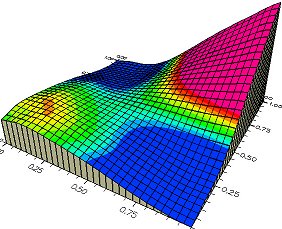Feb 22 2005
 Researchers at the University of Bath have won a £261,000 grant to use the latest software to produce a blueprint of a designer drug that could stop influenza and some other diseases from replicating in humans.
Researchers at the University of Bath have won a £261,000 grant to use the latest software to produce a blueprint of a designer drug that could stop influenza and some other diseases from replicating in humans.
The announcement of the grant comes at a time when fears are rising that an influenza outbreak developing from Asian chickens could kill thousands of people.
Professor Ian Williams, of the Department of Chemistry, will begin work in April on a project that could help pharmaceutical companies develop a better drug that could be taken by people coming down with flu to stop the disease developing.
The drug would work by being chemically very similar to part of the protective coating around the cells in our throats that the flu virus first attacks when a person becomes infected. The flu virus would be deceived into attacking the drug, called an inhibitor, instead of the cells.
The three-year project will be largely carried out by examining the behaviour of atoms of the influenza virus which attack cells, and atoms of the throat cells that are attacked. By using advanced software to model the way these atoms behave in highly complex interactions, the atomic structure of a suitable drug can be worked out.
Using computer modelling in this way can be of great assistance in drug design. Normally drugs are produced by trial and error in a process that can take many years.
Professor Williams and his colleague Dr Gus Ruggiero will use part of the grant from the Biotechnology and Biological Sciences Research Council to buy computers with a combined power many times that of the most advanced desktop machines.
This will be the first time the software, developed in Germany, will have been used in Britain. It will allow accurate modelling of the behaviour of tens of thousands of atoms, many times more sophisticated than previous work.
“Developing a blueprint for a new way of fighting influenza is a very important task," said Professor Williams.
“We often think of flu as just a nasty illness which puts us in bed for a few days. But some outbreaks can cause death on a large scale – the world-wide outbreak in 1918 killed more people than the First World War itself. We may now be facing another flu outbreak, this time originating from chickens in Asia.
“If we are successful, we will have taken important steps in finding a new way of fighting influenza and other diseases. It will then be for the pharmaceutical companies to take our blueprint and turn it into a drug.”
Professor Williams said that his work is a more sophisticated development from similar modelling which produced two anti-influenza drugs, Relenza and Tamiflu, whose effectiveness is limited.
He and Dr Ruggiero will study sialidases, enzymes used by the flu virus to snip off a special type of sugar, sialic acid, from the throat cell, allowing the virus to enter the cell and reproduce.
The new drug would be chemically similar to the sialic acid, but would act to inhibit the sialidase. This would hinder the virus from entering the cells, and from leaving them should they gain entry, thereby controlling the spread of the infection.
Because of similarities between the enzymes used by different viruses and bacteria, a similar approach may also be useful in fighting other diseases such as the South American sleeping sickness, Chagas Disease.